Travelers to Ho Chi Minh City can embark on a journey that uncovers the captivating history and vibrant culture of the Cu Chi Tunnels and the Mekong Delta. The intricate underground network of the Cu Chi Tunnels offers a glimpse into the resilient tactics and survival methods of Vietnamese guerillas during wartime. Cruising along the Mekong River, visitors can enjoy the serene beauty of the region, witnessing the skilled craftsmanship of local artisans and savoring the flavors of the Mekong Delta’s renowned culinary offerings. From the tunnels’ wartime legacy to the delta’s thriving communities, this dynamic destination promises to captivate the senses and reveal the rich tapestry of Vietnam’s past and present.
Key Points
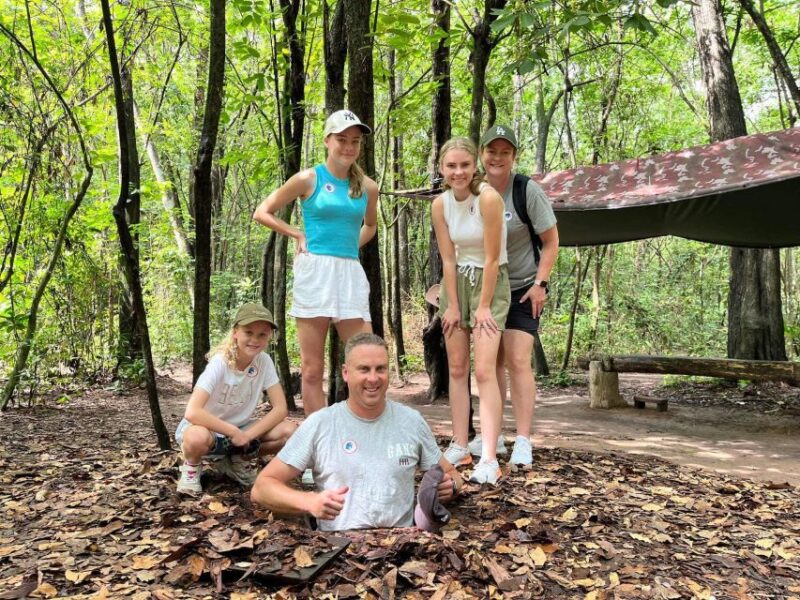
-
The Cu Chi Tunnels provided an intricate underground network that sheltered Vietnamese guerillas during the war, offering an opportunity for visitors to explore their living and fighting methods.
-
The Mekong Delta region showcases the local way of life, with visitors able to cruise the river, observe skilled sampan rowers, and immerse in the serene beauty of the area.
-
Coconut candy production in the Mekong Delta region highlights the culinary heritage and ingenuity of the local artisans, allowing visitors to savor the tropical flavors.
-
Traditional folk music, such as the đàn tranh (16-string zither) and sáo (bamboo flute), are integral to the cultural experience in the Mekong Delta villages.
-
The Mekong Delta’s hometown flavors, including bánh mì, phở, and bánh flan, provide a delightful culinary experience that captures the essence of the region.
Exploring the Cu Chi Tunnels

Visitors to the Cu Chi Tunnels can enjoy the ingenious ingenuity of the underground network that once sheltered Vietnamese guerillas during the war.
They’ll explore the intricate tunnel system, learning how the guerillas lived, resisted, and fought within its confines. Visitors can observe the clever camouflage techniques and secret refuge sites used to evade detection.
For the adventurous, there’s even an opportunity to crawl through the narrow tunnels themselves.
Along the way, they’ll watch war documentaries and footage, and may even choose to take aim at the firing range, for an additional fee.
Ultimately, they’ll savor the taste of tapioca cooked on a traditional Hoang Cam stove, providing a flavorful glimpse into wartime sustenance.
Fascinated by Ho Chi Minh City's past? More historical tours we've covered
Wartime Survival in the Tunnels
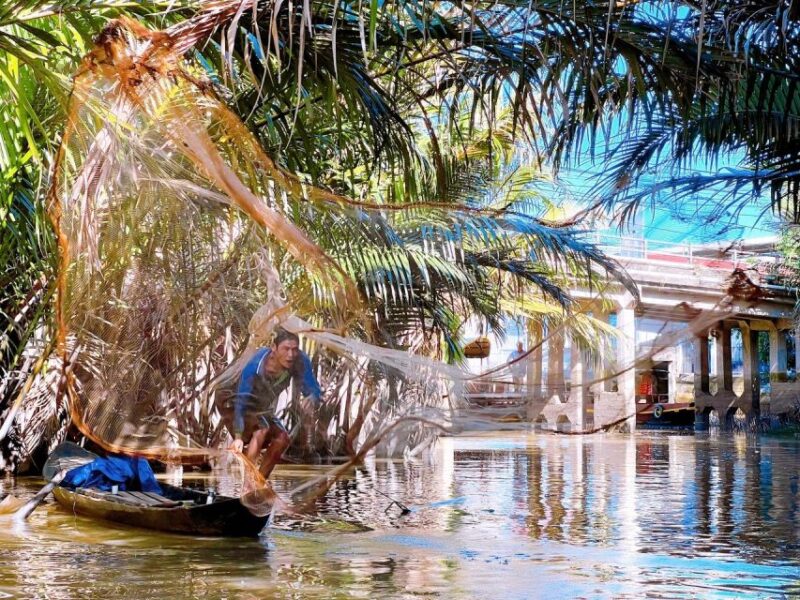
Living in the intricate tunnel network, the Vietnamese guerillas ingeniously adapted to the harsh realities of wartime, devising clever camouflage techniques and hidden refuges to evade detection by their enemies.
Tourists can observe these remarkable survival methods during their visit to the Cu Chi Tunnels.
The guerillas’ ability to withstand the grueling conditions was truly astounding. They employed several key strategies to sustain themselves, including:
- Constructing hidden underground rooms to shelter from bombings and provide refuge for the wounded.
- Camouflaging entrances to the tunnels, blending them seamlessly into the surrounding environment.
- Maintaining a self-sufficient food supply by cultivating plants and raising small animals within the tunnel system.
These ingenious adaptations allowed the guerillas to outlast the American forces and ultimately emerge victorious.
Camouflage and Secret Refuge Sites
To evade detection by their enemies, the guerillas ingeniously camouflaged the entrances to the tunnels, blending them seamlessly into the surrounding environment. Leaves, grass, and other natural materials were used to obscure the tunnel openings, making them virtually invisible from the surface.
The guerillas also created secret refuge sites within the tunnel network, hidden compartments where they could hide from invading forces. These concealed shelters, camouflaged with utmost care, provided essential sanctuary during times of intense combat.
The guerillas’ masterful use of camouflage and refuge sites played a pivotal role in their ability to withstand the relentless attacks and maintain control of the strategically important Cu Chi region.
Cruising the Mekong River
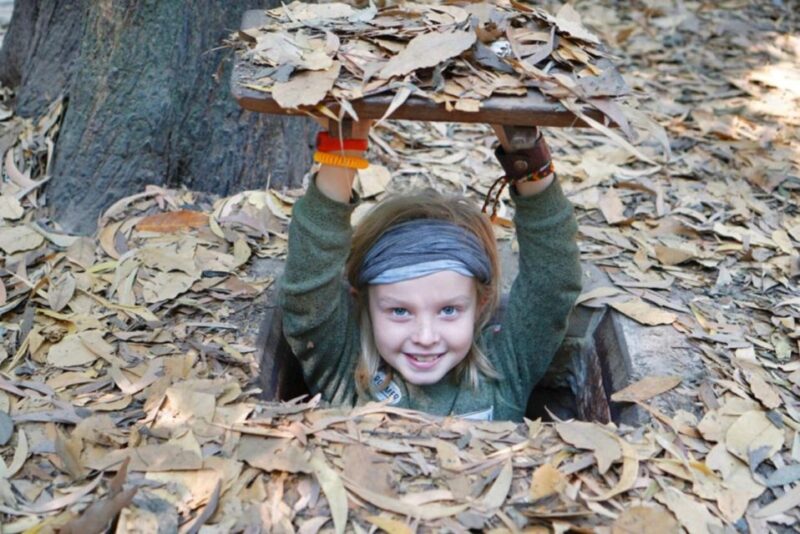
After exploring the intricate tunnel network and learning about the guerillas’ ingenious camouflage techniques, visitors can now enjoy the serene beauty of the Mekong River.
They’ll cruise along its winding waterways, observing the bustling fisherman’s ports and the alluvial flow that has nourished the region for generations.
The tranquil journey offers a glimpse into the local way of life:
Witnessing the skilled maneuvers of the traditional sampan rowers as they navigate the narrow canals.
Visiting a coconut candy production site and savoring the diverse tropical fruit offerings.
Listening to the soothing melodies of local folk music that echo through the peaceful villages and lush fruit gardens.
More Great Thing To Do NearbyCoconut Candy Production
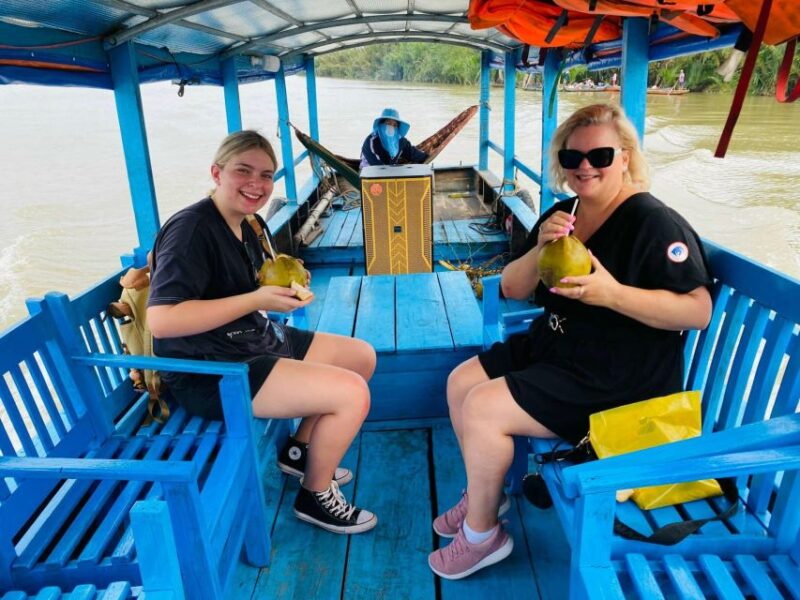
As visitors explore the Mekong Delta, they’ll have the opportunity to witness the intricate process of coconut candy production, a beloved regional delicacy.
At a local workshop, they’ll see skilled artisans hand-crafting coconut candies using traditional methods. The process begins with grating fresh coconut meat, which is then cooked with sugar and water to create a rich, creamy mixture.
This mixture is then poured into molds and allowed to set before being cut into bite-sized pieces. Visitors can sample the various flavors, which may include pandan, vanilla, or even chili for a spicy kick.
The coconut candy production showcases the ingenuity and culinary heritage of the Mekong Delta region.
- Cu Chi Tunnels & Mekong Delta Group Tour Full Day
- From Ho Chi Minh: Full-Day Vung Tau Beach & The Giant Jesus
- From Ho Chi Minh: Vung Tau Beach – The Most Beautiful Beach
- Ho Chi Minh City: Fun and Easy Coffee Workshop for Beginners
- From HCM: Mekong Delta & Cai Rang Floating Market 2-Day Tour
- From Ho Chi Minh City: Mekong Discovery Tour
Tropical Fruits and Honey Tea
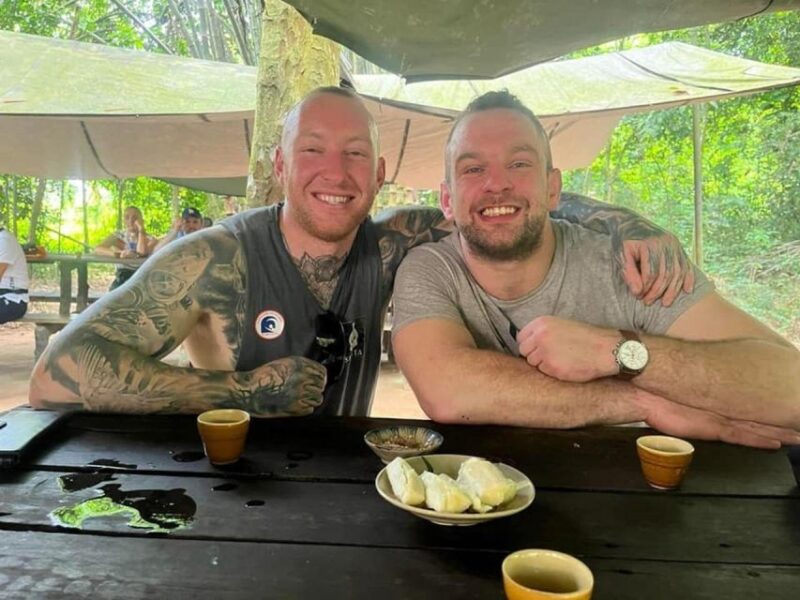
Alongside the serene waterways, visitors to the Mekong Delta can indulge in the region’s bounty of tropical fruits and invigorating honey tea. Ripe mangoes, juicy pineapples, and fragrant lychees are often plucked straight from the orchards, offering a sweet and succulent taste of the local landscape.
The region’s honey tea, infused with the nectar of the delta’s abundant flowers, provides a rejuvenating respite from the warm, humid air.
Some notable highlights include:
- Sipping on a glass of pure, golden honey tea while watching the slow flow of the Mekong River.
- Savoring the burst of tropical flavors in a freshly picked fruit salad.
- Strolling through lush, verdant gardens filled with the scent of ripening produce.
Local Folk Music and Villages
Visitors exploring the Mekong Delta enjoy the region’s vibrant local folk music, often performed by skilled artisans in peaceful riverside villages. The soothing melodies of traditional instruments like the đàn tranh (16-string zither) and the sáo (bamboo flute) fill the air, transporting listeners to a bygone era. As they stroll through the quaint villages, travelers can observe the intricate craftsmanship of local artisans weaving baskets, carving wooden figurines, and producing colorful textiles. The tranquil atmosphere and the warm hospitality of the villagers create a truly immersive cultural experience, allowing visitors to connect with the essence of Mekong Delta life.
| Instrument | Description | History |
|---|---|---|
| Đàn tranh | 16-string zither with a distinctive sound | Originated in the 10th century, used in court music and folk traditions |
| Sáo | Bamboo flute with a soothing, mellow tone | Played in various Vietnamese folk music genres for centuries |
| Đàn bầu | Single-string lute with a haunting, resonant sound | Developed in the 19th century, associated with southern Vietnamese folk music |
Hometown Flavors at Lunch
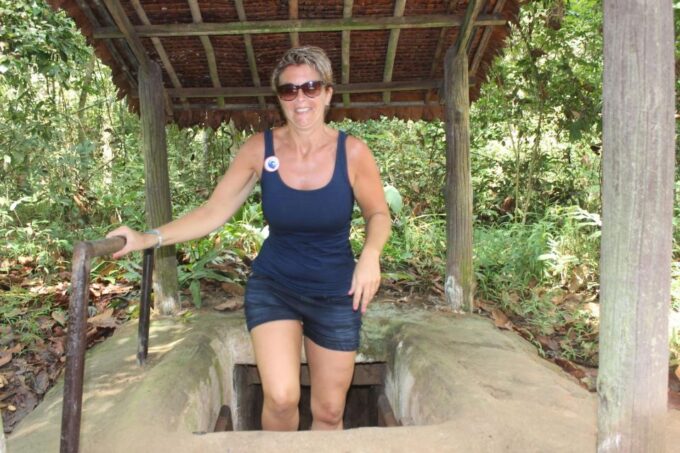
Amidst the tranquil ambiance of the Mekong Delta, visitors savor a delectable lunch featuring a rich tapestry of hometown flavors.
The culinary experience begins with sizzling bánh mì, a beloved Vietnamese sandwich that tantalizes the taste buds with its harmonious blend of crispy bread, savory meats, and zesty condiments.
Next, there’s the fragrant phở, a nourishing noodle soup that warms the soul, its aromatic broth simmered to perfection.
And for a sweet finale, the creamy, luscious bánh flan captivates with its silky custard texture and caramelized top.
These beloved dishes, infused with the essence of the Mekong, offer a delightful immersion into the heart and flavors of Vietnamese cuisine.
Frequently Asked Questions
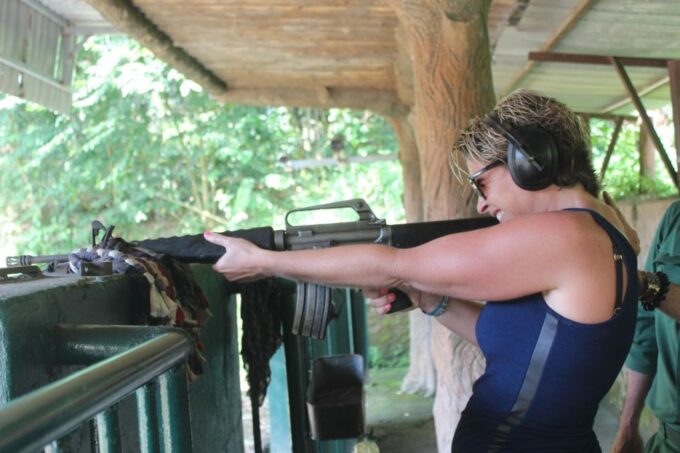
What if I’m Claustrophobic? Can I Still Visit the Tunnels?
Those who are claustrophobic can still visit the Cu Chi Tunnels. The tour provides the option to explore the tunnel entrance and view the tunnels without going inside. Visitors can learn about the history and resistance from above ground.
How Do I Prepare for the Weather Conditions During the Tour?
Dress in lightweight, breathable clothing as the weather in southern Vietnam can be hot and humid. Wear comfortable walking shoes and bring sun protection like a hat and sunscreen. Staying hydrated by drinking plenty of water is also recommended.
Are There Any Age or Physical Requirements to Participate?
There are no strict age or physical requirements, but the tour involves walking, climbing, and traversing narrow tunnels. Visitors should be able to handle these activities comfortably. Children under 12 may require parental supervision.
Can I Take My Own Food and Drinks on the Tour?
Participants are generally not allowed to bring their own food and drinks on the tour. The tour includes lunch, snacks, and bottled water as part of the package. Any personal items or expenses not listed are the responsibility of the participants.
How Can I Best Support the Local Communities We Visit?
One way to best support local communities is to purchase goods and services from them during the tour. This directly benefits the people by providing income and helps sustain their traditional way of life.
Recap
Exploring the Cu Chi Tunnels and cruising the Mekong Delta provides a window into Vietnam’s engaging history and vibrant culture.
Visitors can enjoy the resilience of Vietnamese guerillas, the skilled craftsmanship of local artisans, and the flavors of traditional cuisine.
This journey offers a unique opportunity to uncover the richness of Vietnam’s past and present.
You can check if your dates are available here:More Historical Tours in Ho Chi Minh City
- Chinatown Heritage Highlights Half-day Tour
- Ho Chi Minh City: Historical Journey Guided Tour in Saigon
- Morning Tour: Discovering Ho Chi Minh Citys Historic Gems
- Private Saigon History, Hidden Gems-Scooter Sightseeing Tour
- Historical Walking Tour of Saigon
- HoChiMinh: Discover Cu Chi Tunnels-A Journey Through History
More Tour Reviews in Ho Chi Minh City
- From HCM: 2-Day Tour Mekong Delta, Cai Rang Floating Market
- From Ho Chi Minh: Mekong Delta 2 Days 1 Night
- From Ho Chi Minh: Can Gio Mangrove Forest Private Tour
- Ho Chi Minh City: Full Long Tan Battlefield Tour
- Mekong Delta 3-Day: Saigon to Phnom Penh Gateway
- From Ho Chi Minh City: Mekong Delta 2 Days Group Tour
Not for you? Here's more things to do in Ho Chi Minh City we have recnetly reviewed
- From HCM 1-Day Cai Rang Floating Market Local Mekong Village
- Phu My Port Shore Excursion Tour Cu Chi Tunnels & City Tour
- Floating Market, Flower Village Authentic Mekong Delta Tour
- 2-Day Mekong Delta Private Tour: Vinh Long, Can Tho & Sa Dec
- From Ho Chi Minh: Cai Rang Floating Market and Mekong Delta
- From Saigon: Classic Mekong Delta Full Day Tour
- Phu My Port: Ho Chi Minh City Highlights Tour
- From Ho Chi Minh: Private Vung Tau Beach Tour With Lunch
- Cat Tien National Park Private Tour With Female Tour Guide
- Ho Chi Minh City: Mekong Delta Full-Day Tour
- From Ho Chi Minh: Mekong Delta and Tra Su Forest 3D2N Tour
- Ho Chi Minh: Private Mekong Delta Day Trip With Boat Ride
